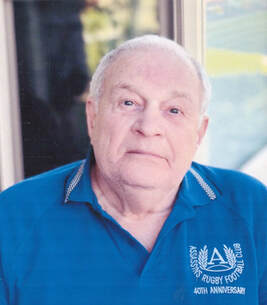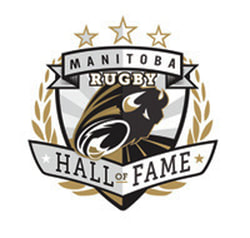
Bob Rialland – Pioneer
Bob grew up in the Riverview neighborhood of Fort Rouge during the 1950s-60s, a time when many enthusiastic and sports-minded lads were participating in the many outstanding community and school sports programs. Not surprising many participants of these programs went on to distinguish themselves in amateur and professional sport. Bob was no exception. From a young age, he excelled in a variety of sports including football, track and skiing, but rugby was Bob’s true calling.
It was during the spring of 1967 when Bob first developed his passion for rugby. He and his friend, Clint Evans (2020 MRHOF Pioneer), were recruited by Ian Williams (2010 MRHOF Pioneer) to play for the Winnipeg Wasps Rugby Club, a club which regularly practiced on Churchill Drive not far from their
homes in Riverview. Bob immediately embraced the game with its fierce competition and requirements for stamina and skill. In May 1967 he experienced his first taste of inter-provincial rugby play when he traveled with the Wasps to Edmonton, Alberta to play against the Edmonton Pirates.
Bob quickly became respected in rugby circles owing to his passion for the game and his spirited and
aggressive style of play. He deeply valued the sense of brotherhood shared between players within a
club as well as the camaraderie with players from opposing clubs. Bob enjoyed the social aspect of the
game and could always be counted on to help organize fundraising socials and off-season events to keep
the connections with teammates strong. His enthusiasm for rugby was infectious and in no time other
lads from Fort Rouge were joining the ranks of the Wasps.
During the fall of 1967, Jim Platt (2011 MRHOF Pioneer) a Wasp teammate and outstanding player, pitched the idea to Churchill High School (CHS) players of developing a new rugby team, a team of “home-grown” Canadian boys. The proposal was well-received and soon thereafter Bob and Clint organized meetings of interested players in his parent’s ‘rec room.’ There was no shortage of players, especially from the CHS cohorts who regularly participated in “pick-up” snow football games on Churchill Drive during the winter months. Bob had a way of recruiting players that one could not ignore.
His sheer enthusiasm made it almost impossible to decline the offer to try this new sport. The first Assassins’ executive was formed during late fall 1967 with Bob serving as first team captain (1968) and Clint serving as first club president and Jim Platt as coach. By the spring of 1968, the Assassins were fielding a new team in the Manitoba Rugby Football Union (MRFU) first division. Bob was instrumental in founding and developing this new club, including choice of team name and for providing leadership both on and off the field. Notably, Bob’s brother-in-law designed the club’s crest, the letter ‘A’ surrounded by a laurel wreath, a symbol which remains to this very day.
By 1969 the Assassins had entered teams in both the first and second divisions of the MRFU and in 1971 the Assassins won their first Division 1 men’s championship. It was Bob, along with Clint Evans and Jim Platt, who were the initial driving force that gave wind to the Assassins’ wings which was to see them grow to include a first division men’s team, a first division woman’s team and two second division men’s sides that over the next 50 plus years would go on to win numerous first and second division Provincial and League championships.
Bob continued to play with the Assassins through the 1970’s but was eventually sidelined with significant injury to his knees and hips. Now living in the Okanagan, Bob still loves the team he helped build into a powerhouse and demonstrated his connection to the team by travelling to Winnipeg for both the Assassins’ 40th and 50th anniversary celebrations. Bob can often be seen proudly sporting his Assassins shirts.
Bob is well-respected in rugby circles for his pioneering efforts in conceiving, planning and building the Assassins RFC, as well as for his athleticism and accomplishments as a team leader and player. His impact on the Assassins RFC and rugby in Manitoba are far reaching and undeniable and their significance worthy of distinction.
Bob grew up in the Riverview neighborhood of Fort Rouge during the 1950s-60s, a time when many enthusiastic and sports-minded lads were participating in the many outstanding community and school sports programs. Not surprising many participants of these programs went on to distinguish themselves in amateur and professional sport. Bob was no exception. From a young age, he excelled in a variety of sports including football, track and skiing, but rugby was Bob’s true calling.
It was during the spring of 1967 when Bob first developed his passion for rugby. He and his friend, Clint Evans (2020 MRHOF Pioneer), were recruited by Ian Williams (2010 MRHOF Pioneer) to play for the Winnipeg Wasps Rugby Club, a club which regularly practiced on Churchill Drive not far from their
homes in Riverview. Bob immediately embraced the game with its fierce competition and requirements for stamina and skill. In May 1967 he experienced his first taste of inter-provincial rugby play when he traveled with the Wasps to Edmonton, Alberta to play against the Edmonton Pirates.
Bob quickly became respected in rugby circles owing to his passion for the game and his spirited and
aggressive style of play. He deeply valued the sense of brotherhood shared between players within a
club as well as the camaraderie with players from opposing clubs. Bob enjoyed the social aspect of the
game and could always be counted on to help organize fundraising socials and off-season events to keep
the connections with teammates strong. His enthusiasm for rugby was infectious and in no time other
lads from Fort Rouge were joining the ranks of the Wasps.
During the fall of 1967, Jim Platt (2011 MRHOF Pioneer) a Wasp teammate and outstanding player, pitched the idea to Churchill High School (CHS) players of developing a new rugby team, a team of “home-grown” Canadian boys. The proposal was well-received and soon thereafter Bob and Clint organized meetings of interested players in his parent’s ‘rec room.’ There was no shortage of players, especially from the CHS cohorts who regularly participated in “pick-up” snow football games on Churchill Drive during the winter months. Bob had a way of recruiting players that one could not ignore.
His sheer enthusiasm made it almost impossible to decline the offer to try this new sport. The first Assassins’ executive was formed during late fall 1967 with Bob serving as first team captain (1968) and Clint serving as first club president and Jim Platt as coach. By the spring of 1968, the Assassins were fielding a new team in the Manitoba Rugby Football Union (MRFU) first division. Bob was instrumental in founding and developing this new club, including choice of team name and for providing leadership both on and off the field. Notably, Bob’s brother-in-law designed the club’s crest, the letter ‘A’ surrounded by a laurel wreath, a symbol which remains to this very day.
By 1969 the Assassins had entered teams in both the first and second divisions of the MRFU and in 1971 the Assassins won their first Division 1 men’s championship. It was Bob, along with Clint Evans and Jim Platt, who were the initial driving force that gave wind to the Assassins’ wings which was to see them grow to include a first division men’s team, a first division woman’s team and two second division men’s sides that over the next 50 plus years would go on to win numerous first and second division Provincial and League championships.
Bob continued to play with the Assassins through the 1970’s but was eventually sidelined with significant injury to his knees and hips. Now living in the Okanagan, Bob still loves the team he helped build into a powerhouse and demonstrated his connection to the team by travelling to Winnipeg for both the Assassins’ 40th and 50th anniversary celebrations. Bob can often be seen proudly sporting his Assassins shirts.
Bob is well-respected in rugby circles for his pioneering efforts in conceiving, planning and building the Assassins RFC, as well as for his athleticism and accomplishments as a team leader and player. His impact on the Assassins RFC and rugby in Manitoba are far reaching and undeniable and their significance worthy of distinction.


